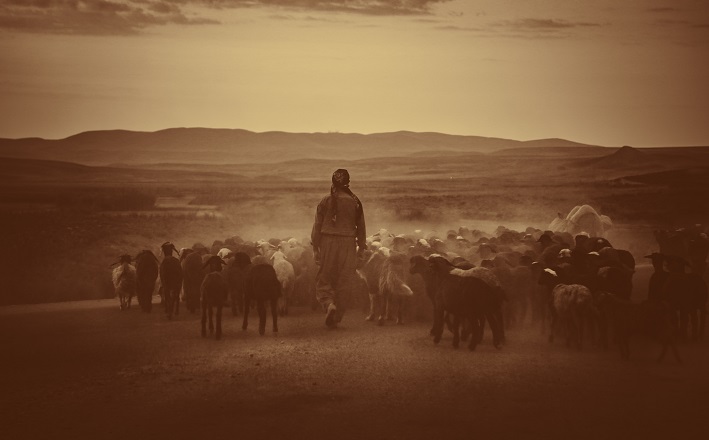I have a special relationship with Jesus as the good shepherd. My dad was the pastor of Shepherd of the Hills Lutheran Church in Tiburon, California, and my mom was a teacher in the church’s preschool, Little Lambs Nursery School. We lived on 9 Shepherd Way.
Growing up (and my dad still has it) my parents had a unique wood mosaic depicting Jesus as the shepherd created by my father’s dearest friend from seminary. It always had a prominent location in our house. And my Ph.D. dissertation was on Jesus as the shepherd, brilliantly titled, “Rereading the ‘Shepherd Discourse’: Restoring the Integrity of John 9:39—10:21.” All this and never in my life having a personal encounter with sheep, or a shepherd for that matter, except for at a petting zoo.
I “ran into” a shepherd on my first trip to Israel/Palestine with a group of students from Luther Seminary. While were having lunch overlooking Jerusalem, I turned around, and lo and behold! A shepherd! With sheep! I took about a thousand photos. The first hundred or so were less than pastoral, with the shepherd on his cellphone—setting up happy hour or a coffee break with fellow shepherds at another pasture? But there was something spiritual about that encounter. My mind flooded with memories. Memories of my mom and dad and our PK (pastor’s kid) family life in the parsonage on Shepherd Way. My heart filled to its brim with feelings. Feelings about my doctoral days, being “shepherded” by my Doctor Mother, Gail R. O’Day. My last semester of course work included a seminar with her on the Gospel of John. At that point, you are desperate for a dissertation topic, and I was at a loss. On the last page of my final paper, Gail wrote, “I think this is a dissertation topic—and I think it could be done by you.”
We know, Dear Working Preachers, the impact various images of Jesus have on us—and on those with whom we do ministry. People have embedded Christologies—shaped by the representations of Jesus that have surrounded them throughout their lives. How Jesus is portrayed in your spaces of worship has deeply influenced the Christology of your congregation. Resistances to any “Jesuses” that challenge these entrenched portraits are real. We are knocking on the front door of carefully constructed theological houses of cards. Often when there is push back to our preaching, it’s usually not what we said but what Scripture says. The rejections especially surface when it comes to Jesus. Because if we can imagine anything like a relationship at all with the Godhead, let’s face it—Jesus is easier. He was human, after all. Yes, God became human, but still. God is God. And the Holy Spirit? Hard to have “relationship” as we humans know it with breath, wind, spirit—or a dove.
With these many depictions of Jesus, I often wonder if we preachers have our own resistances to sharing the fullness of the Christological witness, worried that our listeners would not like the presentation passed down. But as I am wont to say in my classroom, it is part of our calling to proclaim the different Christological portraits presented in the New Testament. Why? You never know what Jesus you are going to need.
Jesus’ identity is in question in John 10:22-30. This is the only time in John where Jesus is asked directly whether he is the Messiah. Jesus’ response, however, is less than clear. Instead of saying, “I have told you that I am the Messiah,” he responds, “I have told you.” What, Jesus? What have you told us? But then, Jesus goes on and connects his identity back to his sheep. He never calls himself the good shepherd here. Rather, he points to his relationship with the sheep. Ah ha. There it is, preachers. Jesus doesn’t answer the inquiry with who he is, but for what he desperately longs—to be in relationship with his sheep. And therein lies the goodness.
I had to sit with that realization for a bit. I want clarity. Jesus wants connection. I want to know what to believe. Jesus wants belonging. I had to sit with Jesus as my shepherd, allowing the memories and the feelings to take over, allowing myself to experience his grace upon grace goodness.
I saw myself as the man born blind who preaches about Jesus, leaning into the truths he knows, but nobody listens—except for the good shepherd. I remembered what it feels like to be rejected … like when the man born blind is thrown out (9:34), lost, cast away from his community, and that’s when Jesus returns to the scene and finds him—just like he found the woman at the well. Unlikely witnesses, even resistant at first, witnesses (enter my call story here). I sensed, just outside my door, those wolves in sheep’s clothing trying to steal me away, or the thieves and the bandits attempting to convince me of other definitions of abundant life—and there was the good shepherd, standing in the way, the gate, protecting me, bringing me back into the fold.
I realized how much I listen to so many other voices, voices from outside and from within, telling me, well, you know what they say—and yet the good shepherd, interrupts the chatter by calling my name, saying “I know you, Karoline, and you know me. Trust me.” I acknowledged how much pulls me away—from my priorities, my vocation, my joy, my God—and the good shepherd reminds me, “No one and no thing will snatch you away from me.”
And I heard the promise from my good shepherd that I needed to hear this week: “I came that you may have life, Karoline, and have it abundantly.”
Karoline

